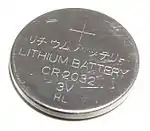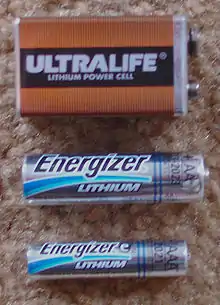Lithium as an investment
As widespread economic turmoil in the first decade of the 21st century resulted in the broad destabilization of many traditional investment products and venues alternative investment options began to realize an increase in popularity among investors who may not have otherwise strayed from established investment practices under previous markets.



Speculation in lithium compounds used as feedstocks for major applications is an example of such a trend. The main intermediates are lithium hydroxide and lithium carbonate, and these are the commodities that the LME has chosen as the most appropriate to establish reference pricing.[1] Speculators hope to make a viable play on a perceived growth in demand for lithium metal due to the widespread adoption of lithium batteries in emerging technologies. Lithium batteries have become a preferred power source for energy-hungry devices such as cell phones because they are more efficient and scalable than previous-generation nickel-metal hydride batteries thus they are in high demand in support of automobile and electronics manufacturing.
Factors that could result in limitations affecting overall lithium supply are seen by some as prescient; with predicted supply chain volatility potentially overpowering other market factors and becoming the primary price driver, essentially resulting in a seller's market and thereby making the metal a profitable investment. However this model tends to disregard the influence of other factors outside basic supply/demand curves such as market regulation and the increased tendency for costlier components to be targeted for replacement by new technologies. Current projections of the global market for lithium-ion batteries range from $26 billion in 2023 (Navigant Research) to a very optimistic $33 billion in 2019 (Transparency Market Research).[2]
Uses of lithium
Lithium metal is an extremely soft, highly reactive, and flammable element. It is most frequently found in deposits such as spodumene and pegmatite minerals, with larger resources in the U.S., Canada, Australia, China, Zimbabwe, and Russia. Lithium possesses a unique chemical profile making it the lightest metal in the periodic table and the least dense solid element. Its atomic number is 3 (right behind helium at 2 and hydrogen at 1), and its density is just 0.53 kg/L. This alkali metal is probably best-known for its wide use in lithium batteries common in all sorts of electronics devices. Other industrial applications include manufacturing heat-resistant glass and ceramics, high-performance alloys used in aircraft, and lubricating greases.[3] Lithium deuteride is used in staged thermonuclear weapons as a fusion fuel. Compounds of lithium are also used as mood stabilizing drugs in psychiatry. The breakdown of the global end-use lithium markets is estimated as follows: ceramics and glass, 31%; batteries, 23%; lubricating greases, 9%; air treatment, 6%; primary aluminum production, 6%; continuous casting, 4%; rubber and thermoplastics, 4%; pharmaceuticals, 2%; and other uses, 15%.[4]
Global resources and production
The global production of lithium is set to quadruple from 20,000 tons in 2000 to 80,000 tons in 2020. Mining lithium metal is not expensive, especially at high mountain plateaus, where lithium is collected from brine ponds evaporated by the sun. In the five years to 2018 the largest increase in world lithium production has come from hard rock mines in Western Australia, with 7 mines now in production.[5]
Identified lithium resources total 5.5 million tons in the United States and approximately 34 million tons in other countries, so lithium is not, in fact, a rare commodity. Identified lithium resources for Bolivia and Chile are 9 million tons and in excess of 7.5 million tons, respectively. Identified lithium resources for Argentina, China, and Australia are 6.5 million tons, 5.4 million tons, and 1.7 million tons, respectively. Canada, Congo (Kinshasa), Russia, and Serbia have resources of approximately 1 million tons each. Identified lithium resources for Brazil total 180,000 tons.[6]
The world’s top 3 lithium-producing countries from 2016, as reported by the US Geological Survey.[7]
Australia
In 2016, Australian companies delivered 14,300 tons of metal, an increase of 1,300 tons from 2014. The country develops the Greenbushes lithium project, which is owned and operated by Talison Lithium. Greenbushes is the world’s largest known single lithium reserve and has been operational for over 25 years. The location also provides easy access for Asian electronics companies, which are the global top lithium consumers. All Australian production to date has been in the form of spodumene concentrate containing approximately 6% LCE, all of which was shipped to China for refining. In 2017-18 Australian production had increased to 2.1 million tonnes of spodumene concentrate worth $1.6 billion. Three separate refineries are under construction which will produce lithium hydroxide and lithium carbonate. [8]
Chile
In 2016, Chilean mines delivered 12,000 tons of lithium, providing the second-highest amount of lithium. Overall, Chile possesses the largest confirmed lithium reserves in the world, with over 7.5 million tons of the element. By that estimate, the country hosts roughly five times more lithium than Australia, which features the second-largest reserves. In particular, the Atacama salt flat is the most significant source of country’s massive lithium production, and it has been reported that one project alone encompasses approximately 20% of the world’s total lithium. While Australia extracts lithium from traditional hard-rock mines, Chile’s lithium is found in brines below the surface of salt flats. These brines are collected and treated in order to separate the element from wastewater.
Argentina
In 2016, for the first time, Argentina overtook China to become the third largest producer of lithium. Argentina has lithium reserves of 9,000,000 tons and the Salar del Hombre Muerto district is a part of the so-called lithium triangle which is believed to be home to half of the world's land based lithium reserves. Due to increased demand worldwide, lithium mining in the country shows no signs of slowing down with output set to triple by 2019.
Canada
Canada is a new entrant into lithium market as a potential supplier.
The Lithium Triangle
The intersection of Chile, Bolivia, and Northwest Argentina make up the region known as the Lithium Triangle. The Lithium Triangle is known for its high quality salt flats including Bolivia's Salar de Uyuni, Chile's Salar de Atacama, and Argentina's Salar de Arizaro. The Lithium Triangle is believed to contain over 75% of existing known lithium reserves.[9]
Investment vehicles
Currently, there are a number of options available in the marketplace to invest in the metal. While buying physical stock of lithium is hardly possible, investors can buy shares of companies engaged in lithium mining and producing.[10] Also, investors can purchase a dedicated lithium ETF offering exposure to a group of commodity producers. As of October 2020, there lithium hydroxide and carbonate futures are not yet traded, but historical reference prices are being established with a view to doing so.[1]
Lithium Index
The performance of the global lithium industry is covered by Solactive Global Lithium Index. The index is composed of companies that are primarily engaged in some aspect of the lithium industry such as lithium mining, exploration, and lithium-ion battery production.
Mining companies
There are many companies relying on lithium for a substantial portion of their revenues. Examples include:
- Ganfeng Lithium is a Chinese lithium refiner, primarily of spodumene from Mt Marion in WA.
- Advantage Lithium, a Canadian based lithium explorer with a large-scale development asset located in the Cauchari basin in Argentina, which now is part of Orocobre
- Sociedad Química y Minera, a Chilean producer of specialty plant nutrients and chemicals that runs large-scale lithium production operations. The main production facilities are located in the Atacama Desert.
- Livent Corporation, Formally FMC Lithium Division was spun-off into a dedicated lithium company in Oct 2018
- Albemarle Corporation, an industrial company producing lithium chemicals
- Bearing Resources, a Canadian miner developing a lithium brine project in Chile and the highest-grade undeveloped project
- Bacanora Minerals, a Canadian miner developing a lithium mine in Mexico, Sonora, first to enter in a conditional supply agreement with Tesla
- Lake Resources, an Australia company which holds tenements in Chile and one of the largest lithium tenement packages in Argentina
- Westwater Resources, Inc. has projects in uranium, graphite, lithium, and vanadium. They have two lithium projects in the early stages of development - one in Utah and the other in Nevada.[11]
- Lithium Americas Corp, a Canadian/Argentinian miner, producer and supplier of lithium, with large-scale assets located Argentina and the U.S. state of Nevada
- RB Energy, a Canadian company developing The Quebec Lithium Project, filed for creditor protection in 2014, according to the Financial Post[12]
- MGX Minerals, a diversified Canadian mining company engaged in petrolithium projects in western Canada and the United States[13]
- Kodal Minerals, a small-cap mining and exploration company that currently focuses on its large lithium project in Mali
- Savannah Resources, a lithium miner based in Portugal and listed in London. The company focuses on hard rock lithium extraction as opposed to the brine extraction found in South America
- E3 Metals Corp, a lithium developer based in Alberta
- MétAmpère Limited, developing a hard rock lithium mine and processing plant in Cornwall, UK
Exchange traded funds
Direct investment
- HWS AG's German Lithium Participation investment programme offers the first direct investment opportunity for lithium. The lithium carbonate is stored in barrels in a German warehouse.
See also
- Alternative investments
- List of countries by lithium production
- Lithium Production
- Lithium Triangle
- Minor metals
- Sprott Molybdenum Participation Corporation
- Traditional investments
- Uranium Participation Corporation
Rare materials as investments
References
- "Lithium at the LME". London Metals Exchange. London Metals Exchange. Retrieved 21 October 2020.
- Howard, Wilmont (May 7, 2014). "The Lithium Industry: Will Supply Meet Demand?". seekingalpha.com. Retrieved 2015-04-24.
- "How to Invest in Lithium". commodityhq.com. Archived from the original on 2015-04-11. Retrieved 2015-04-24.
- "How to Invest in Lithium". elementinvesting.com. Retrieved 2015-04-28.
- "WESTERN AUSTRALIAN MINERAL AND PETROLEUM STATISTICS DIGEST 2017-18" (PDF). Minewral and Petroleum Stats WA Gov.
- "Lithium Statistics and Information". U.S. Geological Survey. 2011.
- "8 Top Lithium-producing Countries". Commodity.com. December 14, 2017. Retrieved 2017-12-14.
- "WESTERN AUSTRALIAN MINERAL AND PETROLEUM STATISTICS DIGEST" (PDF). WA Government Dept Mining and Petroleum/. 2019.
- "The Lithium Triangle"http://latintrade.com/the-lithium-triangle/. Latin Trade. Retrieved 2017-8-13.
- "How to Invest in Lithium". commodityhq.com. Archived from the original on 2015-04-11. Retrieved 2015-04-24.
- Westwater Resources, Inc. (2018-09-26), Westwater Resources - Lithium Market, retrieved 2018-09-26
- "RB Energy meltdown highlights tough times for lithium, rare earth firms". Financial Post. Retrieved 2017-04-01.
- https://www.reuters.com/article/mgx-minerals-lithium-idUSL5N1FH5U7
